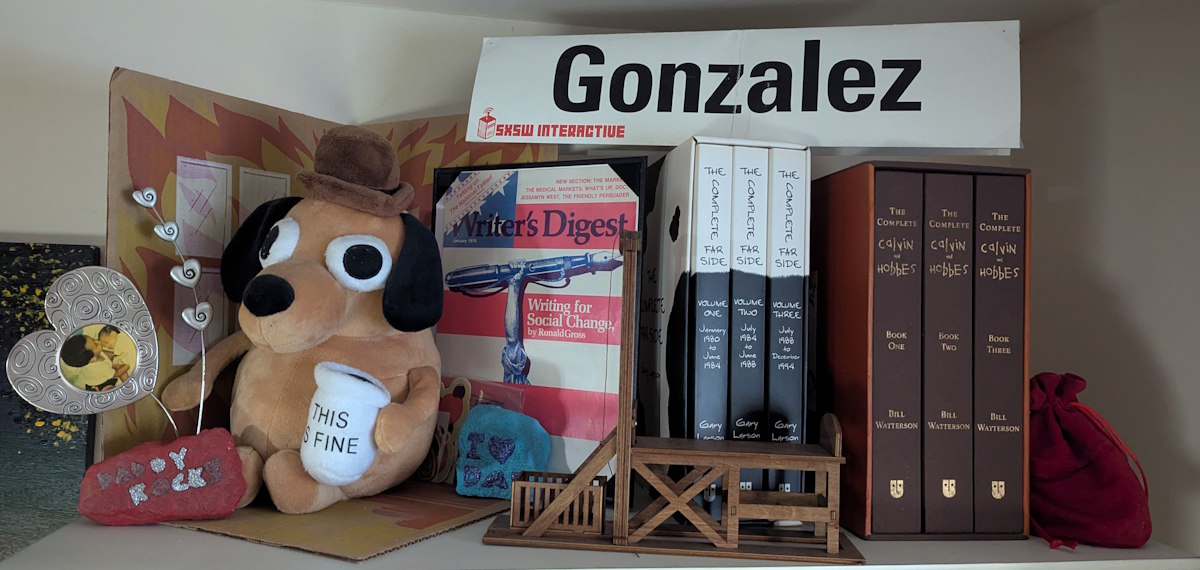This is my bi-weekly “newsletter” delivered straight to your inbox with at least one guaranteed typo I’ll catch after hitting send! If email collectors’ items aren’t your thing, don’t hesitate to switch to the RSS feed or just bookmark loudpoet.com and check in now and then. You do you!
NOTE: I was on vacation when I wrote this, forgive me if it goes astray.
_ONE
Eject disk. | Greg Storey
You’re not burned out because you’re weak. You’re burned out because you’ve been relevant, valuable, over-functioning for too long—inside systems that reward your ability to endure dysfunction and call it leadership.
2025 has been a rough year all around, and the past few weeks have been particularly hard for anyone involved with libraries — from library workers themselves to the library vendors, publishers, and passionate readers who rely on and/or support them in various ways. Maybe it’s because it popped up on my radar while on a much-needed vacation this week, but I suspect Storey’s impassioned call-to-action is something a lot of people I know need to hear right now.
Part slam poem, part fiery sermon, he offers three practical ways to do something about that bad feeling in the pit of your stomach. I like all three options, although I’m leaning towards “Make One Change” first since it’s something I’d already been thinking about a lot the past few weeks while counting down to this break on the calendar.
__TWO
What is “media”? A primer for Americans. | Annalee Newitz
Once you start thinking about your media as a function of technology, you’ll discover that tech has always influenced the content that’s available. A book can’t do what a movie does, and vice versa. Tech also changes the way media is disseminated. Movie theaters made it possible for millions of people to watch the same stories at the same time. Broadcast TV and streaming video allowed millions of people to bring theaters into their living rooms. And social media allowed us to share our living rooms with the world.
Having grown up in the 70s and 80s means I’ve experienced the highs and lows of everything from radio, broadcast TV, and newspapers, to cable news and the internet, to social media and the various “AI” strains it’s helping spread.
In my last serious attempt at college in the mid-90s, I was a Media Studies major, fanning the dying embers of a childhood dream to make movies while not realizing I was in the very early days of an unexpected but more realistic career in marketing. All of the classes I took focused on aspects of media history, but I don’t recall any notable focus on media literacy. I’m pretty sure one of my professors put me on to Neil Postman’s Amusing Ourselves to Death back then, but it was my re-reading of it in 2009 that made it stick — not coincidentally at the height of the “Ebooks will kill publishing!” debates that were raging on social media.
Newlitz’s primer is the first in a series of forthcoming essays. It’s a good refresher if you’ve been in the media business for a while, and a must-read for everyone else who isn’t. They provide a good framework for thinking about the media we consume today, and the follow-up on Stuart Hall, who I was completely unfamiliar with, is a fascinating look at how people decode media.
___THREE
4 fact-checking tips for the age of misinformation and AI hallucinations | Jess Zafarris
For comms and PR pros, a single bad fact in a blog post, press release, executive statement or even LinkedIn caption can snowball into a credibility crisis. And it’s not just AI—outdated statistics, misquoted sources and PR-driven “research” make it easy to spread misinformation, even with the best of intentions. Here’s how to research and fact-check like your reputation depends on it (because it does).
I frequently have to remind myself that most people are simply passive media consumers who don’t give much thought to how the sausage is made, as long as it tastes good and keeps them scrolling. (Or worse, tastes bad but they can’t stop eating it anyway.) The rise of social media and popularity of “content creators” and “influencers,” alongside the self-inflicted decline in credibility of “traditional” media outlets (who blurred the lines themselves by playing games with search engine and social media optimization tricks, sponsored content, and “both sides” shenanigans), means media literacy is dangerously low at a time when access to media is at an all-time high.
While Zafarris’ tips are directed to media professionals, it’s an insightful must-read for regular people who want to be savvier about deciphering what’s appearing in their preferred feeds, whether it’s driven by algorithms or posted by the allegedly credible professionals they follow.
____FOUR
Defense Against Dishonest Charts | Nathan Yau
Numbers and, by extension, charts, can seem like concrete facts. They are not. From the data collection process, to analysis, through published graphics, opinions are expressed through the choices on the way to your eyeballs. Your own interpretation of a chart is linked to what you know and think about the data and topic. But let’s keep our eyes on the charts. Seemingly simple changes can reveal a chartmaker’s point of view.
This one’s for the data nerds but really is a must-read for anyone with an internet connection or access to cable news.
Zafarris addresses data visualizations in her article above, but Yau’s deeper dive is an invaluable follow-up because deceptive charts are arguably the most common misinformation tactic used by too many people — purposefully and accidentally — especially on social media. Similar to Newlitz’s media primer, he offers a foundation for understanding the various types of charts first and then gives a variety of specific examples with interactive charts so you can see exactly how they can be tweaked to deceive you.

_____FIVE
Tuning Out the Algorithm at WFMU | John Erik Hmiel
Today the station continues to archive its playlists and makes them freely available without time restrictions. Indeed, WFMU is the only station in the world that offers this sort of access to free, carefully curated playlists, created by thoughtful and dedicated DJs whose only interest is in sharing the music that they love. As algorithmically determined playlists are redefining both music production and consumption, WFMU represents a lonely alternative that prioritizes artistic expression over profit.
Despite growing up in the 70s as an avid radio listener and Pump Up the Volume being one of my all-time favorite movies (and soundtracks), my musical tastes have always been eclectic, but relatively basic. Other than the early days of hip-hop, there’s not a single musician I can pretentiously claim that “I knew them before they were cool!”
College and independent radio stations never interested me, not even the ones that prominently centered non-commercial rap music, and I can count all of the concerts I’ve ever been to on two hands. On the rare occasions streaming algorithms surface new-to-me artists and music, there’s no DJ offering context. Same for the FIFA soundtracks that were a major discovery source for a few years. My own curated playlists were mostly fixed, too, while my small vinyl and CD collections are mostly familiar favorites.
New Orleans’ WWOZ was the first indie radio station to make a deep impression nearly 15 years ago, partly because their relationship to the community and culture was crystal clear, and partly because it was a great way to explore new-to-me music from my favorite city with expert guidance and context. I was even a regular supporter for several years, a small way of giving back to a place I still have a deep fondness for. (Shoutouts to Offbeat Magazine and the Louisiana Music Factory, too.)
WFMU didn’t really hit my radar until after we bought a 1965 Chevrolet Corvair in late 2020, which only had its original AM radio installed. Most of the music they played was either old rock music I wasn’t interested in, or weird and often uncomfortably off my radar music I never knew existed, but I eventually discovered their archives and Put the Needle on the Record with Billy Jam. It was pure nostalgia, but it was the hook that pulled me in. Over the next several months, I found other shows I liked, including Bodega Pop, Downtown Soulville, Radio Futura, and most recently, The Crescent City Connection. All four play music that’s mostly unfamiliar to me, and even Billy Jam surfaces plenty of oldies I don’t remember at all.
Thanks to their archives and excellent Android app (plus their Mastodon account), “Woof Moo” has become my primary music streaming service, and I’m regularly enjoying listening to “the radio” on-demand, usually during the day while working, or on longer drives. In a full circle moment late last year, after unsuccessfully trying to sell the Corvair for a reasonable price on Craigslist, I saw WFMU took cars as tax-deductible donations and decided to do that instead of accepting an insulting lowball offer. It was auctioned off a month later for more than any of those lowball offers and capped off a third year of supporting the station.
Thanks to Hmiel’s great essay, I now have an even deeper appreciation for what WFMU represents beyond my own personal enjoyment, and I’m even happier to keep supporting it now.
If you’re reading this somewhere other than your inbox and would like to get it via email, sign up here, or you can add the RSS feed to your favorite reader. You do you!
Do you like email?
Sign up here to get my bi-weekly "newsletter" and/or receive every new blog post delivered right to your inbox. (Burner emails are fine. I get it!)

